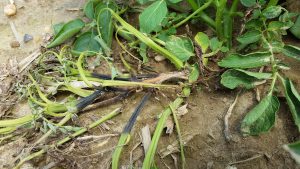Dickeya dianthicola, an aggressive form of blackleg, has been found on potato in New Jersey for a second year in a row. The pathogen has also been found in potato crops in other states in the mid-Atlantic region this summer. The pathogen can cause significant losses if brought into the field on infested seed. Symptoms of Dickeya include the rotting/melting of the infested seed piece without the smell of traditional soft rotting bacteria. The bacterium will spread to other tubers developing on plant and into the stems leading to blackleg symptoms on the foliage. Infected plants can collapse quickly under hot conditions. Surveying and testing for Dickeya is currently being done in all states in the region. All potato growers should scout on a daily basis and any suspect plants should be submitted for testing. In New Jersey, fields of ‘Reba’, ‘Snowden’, and ‘Norwis’ have tested positive for Dickeya dianthicola from seed originating from Maine and Canada.

Symptoms of blackleg caused by Dickeya dianthicola on an infected potato plant.
